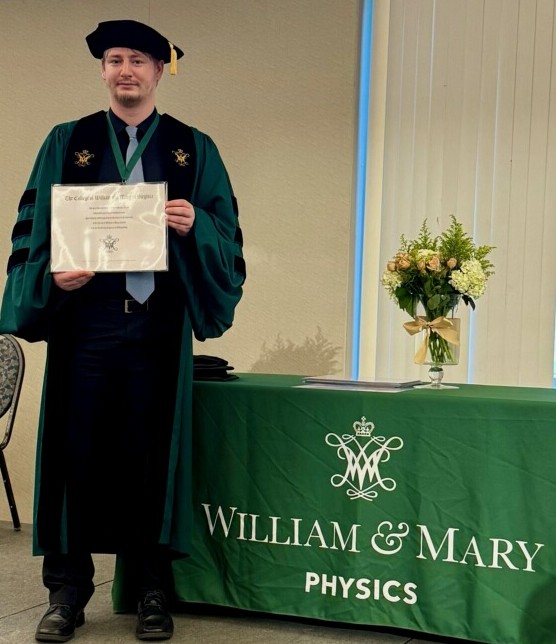William & Mary
My doctoral research with Dr. Jianwei Qiu focused on lepton-hadron scattering process to make predictions for the Electron Ion Collider (EIC). I completed the first calculation of next-to-leading order (NLO) factorized QED contributions to the short-distance hard coefficients of inclusive lepton-hadron deep inelastic scattering (DIS) in a joint QCD and QED factorization approach (DIS2024 proceedings, long paper). Unlike the traditional radiative correction (RC) approach to handle the collision-induced QED contributions to lepton-hadron DIS, QED radiation from all charged leptons and quarks are treated equally and their collinear sensitivities are systematically factorized into corresponding universal lepton and parton distribution functions. Our full NLO factorized QED contribution calculated in the joint QCD and QED factorization approach is completely infrared safe without the need of any parameters in the traditional RC approach other than the standard factorization scale. Our results and the new joint factorization approach will impact the reliability and precision for extracting partonic information from lepton-hadron DIS and semi-inclusive DIS at the future EIC.
William & Mary and Jefferson Lab
Through the DOS SCGSR award and the Jefferson Lab Science Associates Graduate Fellowship, I calculated the invariant matrix element for the simplified photon-quark or photon gluon interactions, both by hand and using Mathematica. Using these matrix elements, I derived an expression for the factorized cross section at leading order, using the new factorization scheme, combining QED and QCD contributions (as presented here), in the rapidity frame. This factorization method accounts for the radiative corrections to the single photon exchange without having to adjust the scattering amplitude, only the introduced lepton distribution functions and lepton fragmentation functions. After writing code to simulate this cross section, working with Dr. Nobuo Sato, and Dr. Wally Melnitchouk as part of the DOE SCGSR award, I began making predictions for the collinear contribution to collisions at the future EIC. Through an expansion to the TMD region, predictions can be made for JLab as well.
Lebanon Valley College
My senior year of undergrad research at LVC was with Dr. Daniel Pitonyak, working on Quantum Chromodynamics (QCD) and Quantum Field Theory (QFT). It involved calculating the cross section for Deep Inelastic Scattering (DIS) and the next to leading order (NLO) correlator correction. I also updated python code used to calculate the asymmetry for the unpolarized electron-proton interaction, as well as introduced a correction to the previous function. The main collaboration, JAM3D, has more information here.
COMPASS
While at CERN, I used COMPASS data to extract the Sivers and Worm-Gear first kT moment using point-by-point extraction. I took asymmetries measured by the COMPASS experiment and used the global fits for PDFs and FFs to calculate the first transverse moment of the Sivers function, which describes the correlation between an unpolarized lepton and a transversely polarized proton. Using the same process for different data, I calculated the first moments of the Worm-Gear T function, describing the correlation between a longitudinally polarized lepton and a transversely polarized proton.
REDTOP
At FNAL, I modeled modifications to the delivery ring for the REDTOP experiment. The REDTOP project proposes using the delivery ring on the Muon campus at Fermilab to decelerate protons before using third-integer resonant extraction to strike a target and produce eta particles. This process risks destabilizing the beam, and modifications to quadrupoles were proposed to minimize beam loss. Using MAD-X, I modeled these changes and used the software to calculate the Twiss parameters, finding minimal loss as the energy of the beam decreased. To shape the beam for extraction, sextupoles were introduced into the program and I simulated multiple turns of the beam, monitoring the distribution of the particles. The strengths of the sextupoles were adjusted until the beam formed a triangle at the extraction point.
Quantum Information Science
With Dr. David Lyons and Dr. Scott Walck at LVC, I investigated the Werner Basis Conjecture, which describes the class of quantum states called Werner States, states invariant under the same unitary evolution operator acting on each particle, specifically the set of Werner States constructable from non-crossing polygon diagrams. It says these states form a basis for the entire space of Werner States. Previous work showed the size of the set matched the dimension of the space, so I was tasked to determine the linear independence. This process involved many dead ends as I tested possible avenues in low dimensional spaces and generalized the process. The final, and most promising, idea was to use the specific permutation matrices created from non-crossing polygon diagrams, which are known to form a basis over the permutation matrices, and to relate them to Werner States, leveraging the known basis to prove our new basis. For more information about the group, visit their main site.
Papers
Joint Factorization of QCD and QED Radiation in Lepton-Hadron Scattering (Thesis)Factorized QED and QCD Contribution to Deeply Inelastic Scattering
Factorized QED Contribution to Lepton-Hadron DIS
Origin of single transverse-spin asymmetries in high-energy collisions
Reports
Calculation of the Deep Inelastic Scattering Cross SectionExtraction of first tranverse moment of Sivers and g1T⊥ TMD PDFs from polarized SIDIS COMPASS data
REDTOP Beam Modeling For Raised Transition Energy and Third Integer Resonance Extraction
Investigating the Werner Basis Conjecture
Posters
Factorization of Lepton Radiation in SIDISExtraction of first tranverse moment of Sivers and g1T⊥ PDFs from polarized SIDIS COMPASS data
REDTOP Beam Modeling For Raised Transition Energy and Third Integer Resonance Extraction
Investigation of the Werner Basis Conjecture
Presentations
Joint Factorization of QCD and QED Radiation in Lepton-Hadron Scattering (EIC Workshop, 2025)The Impact of QED Effects in SIDIS (Seminar at Jefferson Lab)
Factorization of Lepton Radiation in SIDIS (DNP, 2022)
Extraction of first tranverse moment of Sivers and g1T⊥ PDFs from polarized SIDIS COMPASS data
REDTOP Beam Modeling For Raised Transition Energy and Third Integer Resonance Extraction
Investigation of the Werner Basis Conjecture
